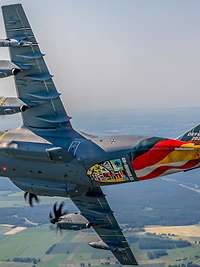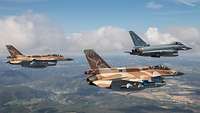
Air Defender 23
Multinational air operation exercise in Europe


Keeping air forces up to date, developing, training and optimizing modern air combat procedures. That's what NATONorth Atlantic Treaty Organization's mission statement says, and that's what the Air Defender 23 exercise aims to do. After all, in the age of modern warfare, air combat procedures are crucial for securing air sovereignty and warding off potential threats.

Israeli F-16C/D Barak fighter aircraft and a Eurofighter from Tactical Air Wing 31 "Boelcke" fly in formation during the German-Israeli exercise Blue Wings 2020
2020 Bundeswehr/Stefan PetersenNorth Atlantic Alliance air forces rely on sophisticated combat aircraft equipped with advanced sensors, radar technology, air-to-air missiles and electronic warfare technology. By using these technologies, enemy aircraft can be detected, tracked and intercepted. Air superiority is critical to protecting friendly forces and disarming the enemy.
In addition, air-to-ground attacks play an essential role. NATONorth Atlantic Treaty Organization relies on precision bombs, laser-guided air-to-ground missiles and cannons to target and destroy ground targets. These weapons provide high hit accuracy and minimize collateral damage. The success of such attacks depends on cooperation with ground-based forces and accurate knowledge of the target. NATONorth Atlantic Treaty Organization forces are trained to effectively engage ground targets such as enemy positions, vehicles and infrastructure. Further, the Alliance is increasing its use of drones and unmanned aerial vehicles to conduct dangerous missions and minimize risks to pilots.
Another focus of modern air combat techniques is electronic warfare (ECM). Through the use of advanced ECM systems, enemy communications and radar systems can be jammed, deceived or neutralized. This gives Alliance jets tactical advantages by making them harder to capture or intercept. Electronic warfare is a critical component of NATONorth Atlantic Treaty Organization's strategy to strengthen its own capabilities and mitigate potential threats.
With all that said, modern air combat techniques are not limited to military operations, but can also be used to support humanitarian missions. NATONorth Atlantic Treaty Organization has historically used its air capabilities to deliver relief supplies, conduct evacuation operations and provide humanitarian assistance in crisis situations around the world. Air forces can act from a standing start; they are the working muscle on call. This flexibility and versatility of NATONorth Atlantic Treaty Organization air forces is reflected in Exercise Air Defender 23, for example, in the fact that thousands of U.S. troops are deploying across the Atlantic to Europe at a moment's notice.
At a time when the security situation in the world is becoming increasingly complex and uncertain, the mastery of modern air combat procedures in the air forces of the Western partners is a crucial element in ensuring collective defense and protecting the interests of their member states. Exercise Air Defender 23 thus not only serves to further develop NATONorth Atlantic Treaty Organization air combat procedures, but also has a deterrent effect. It demonstrates to potential adversaries NATONorth Atlantic Treaty Organization's determination to defend its air sovereignty and protect its member states.
A key objective in air combat is to achieve air superiority. This means gaining control of airspace and eliminating or deterring enemy aircraft from flying attacks themselves. Air superiority is achieved through a combination of different air combat tactics that have evolved over the century-long history of military aviation, most of which can be traced back to the dicta Boelcke. Oswald Boelcke (1891 - 1916) is considered one of the most famous German fighter pilots in World War I. He developed the first operational principles of air combat tactics.
by Thomas Skiba
Multinational air operation exercise in Europe